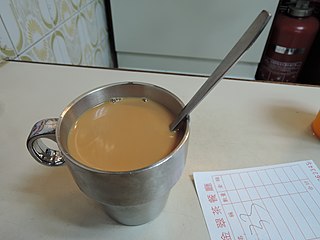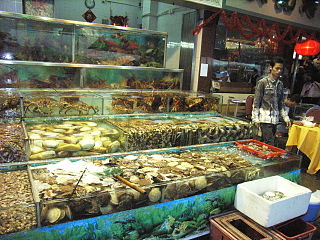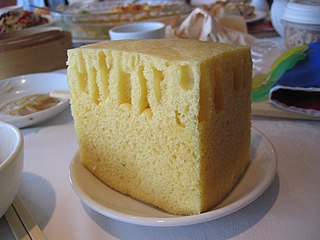
Bubble tea is a tea-based drink that originated in Taiwan in the early 1980s. Taiwanese immigrants brought it to the United States in the 1990s, initially in California through regions including Los Angeles County, but the drink has also spread to other countries where there is a large East Asian diaspora population.

A drink or beverage is a liquid intended for human consumption. In addition to their basic function of satisfying thirst, drinks play important roles in human culture. Common types of drinks include plain drinking water, milk, juice, smoothies and soft drinks. Traditionally warm beverages include coffee, tea, and hot chocolate. Caffeinated drinks that contain the stimulant caffeine have a long history.

Tea is an aromatic beverage prepared by pouring hot or boiling water over cured or fresh leaves of Camellia sinensis, an evergreen shrub native to East Asia which probably originated in the borderlands of southwestern China and northern Myanmar. Tea is also made, but rarely, from the leaves of Camellia taliensis. After plain water, tea is the most widely consumed drink in the world. There are many different types of tea; some have a cooling, slightly bitter, and astringent flavour, while others have profiles that include sweet, nutty, floral, or grassy notes. Tea has a stimulating effect in humans primarily due to its caffeine content.

Dim sum is a large range of small Cantonese dishes that are traditionally enjoyed in restaurants for brunch. Most modern dim sum dishes are commonly associated with Cantonese cuisine, although dim sum dishes also exist in other Chinese cuisines. In the tenth century, when the city of Canton (Guangzhou) began to experience an increase in commercial travel, many frequented teahouses for small-portion meals with tea called "yum cha" (brunch). "Yum cha" includes two related concepts. The first is "jat zung loeng gin", which translates literally as "one cup, two pieces". This refers to the custom of serving teahouse customers two delicately made food items, savory or sweet, to complement their tea. The second is dim sum, which translates literally to "touch the heart", the term used to designate the small food items that accompanied the tea.

Chinese tea culture includes all facets of tea, both physical and spiritual, that significantly influenced Chinese culture throughout history. Physically, it consists of the history of tea cultivation, brewing, serving techniques, methods of consumption, arts, and the tea ceremony. Tea culture is to take tea as a carrier, and through this carrier to spread various arts. Tea culture is an integral part of the excellent traditional Chinese culture, and its content is very rich. Tea culture is the organic fusion of tea and culture, which contains and embodies the manifestation of a certain period of material and spiritual civilization. Tea culture is the combination of tea art and spirit, and the expression of tea art through Spirituality. It emerged in China in the Tang dynasty, flourished in the Song and Ming dynasties, and declined in the Qing dynasty.

Yum cha is the Cantonese tradition of brunch involving Chinese tea and dim sum. The practice is popular in cantonese-speaking regions, including Guangdong province, Guangxi province, Hong Kong, and Macau. It is also carried out in other regions worldwide where there are overseas Cantonese communities. Yum cha generally involves small portions of steamed, pan-fried, or deep-fried dim sum dishes served in bamboo steamers, which are designed to be eaten communally and washed down with hot tea. People often go to yum cha in large groups for family gatherings and celebrations.

Flagstaff House, built in 1846, is the oldest example of Western-style architecture remaining in Hong Kong. It is located at 10 Cotton Tree Drive, Central – within the Hong Kong Park.

Cha chaan teng, often called a Hong Kong-style cafe or diner in English, is a type of restaurant that originated in Hong Kong. Cha chaan teng are commonly found in Hong Kong, Macau, and parts of Guangdong. Due to the waves of mass migrations from Hong Kong in the 1980s, they are now established in major Chinese communities in Western countries such as Australia, Canada, the United Kingdom, and the United States. Likened to a greasy spoon cafe or an American diner, cha chaan tengs are known for eclectic and affordable menus, which include dishes from Hong Kong cuisine and Hong Kong-style Western cuisine. They draw comparisons to Western cafés due to their casual settings, as well as menus revolving around coffee and tea.

Chinese tea generally refers to a variety of teas which are grown or consumed in China.

Hong Kong cuisine is mainly influenced by Cantonese cuisine, European cuisines and non-Cantonese Chinese cuisines, as well as Japanese, Korean and Southeast Asian cuisines, due to Hong Kong's past as a British colony and a long history of being an international port of commerce. Complex combinations and international gourmet expertise have given Hong Kong the labels of "Gourmet Paradise" and "World's Fair of Food".

Hong Kong–style milk tea is a tea drink made from Ceylon black tea and milk. It is usually part of lunch in Hong Kong tea culture. Hongkongers consume approximately a total of 900 million glasses/cups per year. Although originating from Hong Kong, it can also be found overseas in restaurants serving Hong Kong cuisine and Hong Kong–style western cuisine. In the show Top Eat 100, which aired on 4 February 2012, Hong Kong–style milk tea was listed as the 4th most popular food/drink in Hong Kong. The unique tea making technique is listed on the representative list of the Intangible Cultural Heritage of Hong Kong.

Tea culture is defined by how tea is made and consumed, how people interact with tea, and the aesthetics surrounding tea drinking.
Cantonese culture, or Lingnan culture, refers to the regional Chinese culture of the region of Lingnan: twin provinces of Guangdong and Guangxi, the names of which mean "eastern expanse" and "western expanse", respectively.
Milk tea refers to several forms of beverage found in many cultures, First of all, sugar is added to the water along with tea leaves and milk is added after heating it. The term milk tea is used for both hot and cold drinks that can be combined with various kinds of milks and a variety of spices. This is a popular way to serve tea in many countries, and is the default type of tea in many South Asian countries. Beverages vary based on the amount of each of these key ingredients, the method of preparation, and the inclusion of other ingredients Milk tea is the default type of tea in India and Pakistan and referred to as chai.

Yuenyeung is a drink created by mixing coffee with tea. It originated in Hong Kong, where it remains popular.

A Cantonese restaurant is a type of Chinese restaurant that originated in Southern China. This style of restaurant has rapidly become common in Hong Kong.

A teahouse or tearoom is an establishment which primarily serves tea and other light refreshments. A tea room may be a room set aside in a hotel, especially for serving afternoon tea, or may be an establishment that only serves cream teas. Although the function of a tearoom may vary according to the circumstance or country, teahouses often serve as centers of social interaction, like coffeehouses.

Lipton is a British-American brand of tea, owned by Lipton Teas and Infusions. Lipton was also a supermarket chain in the United Kingdom, later sold to Argyll Foods, after which the company sold only tea. The company is named after its founder, Sir Thomas Lipton, who founded it in 1890. The Lipton Ready to drink beverages are sold by "Pepsi Lipton International", a company jointly owned by Unilever and PepsiCo.

Malay sponge cake is a popular dessert cake in Guangdong and in Hong Kong. It usually can be seen at a traditional teahouse in Guangdong and Hong Kong. The cake is made of lard or butter, flour, and eggs, using a bamboo steamer to develop puffiness. An entire Malay sponge cake is a huge yellow round cake, but is generally sold as slices in teahouses. In Hong Kong, where it is very popular, the cake was listed as the "national cake" by the American news channel CNN.
















